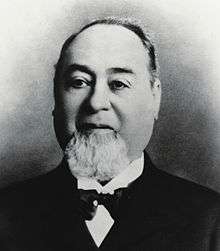Levi Strauss
Levi Strauss (/ˈliːvaɪ ˈstraʊs/, born Löb Strauß, German: [løːp ˈʃtʁaʊs]; February 26, 1829 – September 26, 1902) was a German-born American businessman who founded the first company to manufacture blue jeans. His firm of Levi Strauss & Co. (Levi's) began in 1853 in San Francisco, California.[1][2]
Levi Strauss | |
|---|---|
 | |
| Born | Löb Strauß February 26, 1829 |
| Died | September 26, 1902 (aged 73) San Francisco, California, U.S. |
| Known for | Founding the first company to manufacture riveted blue jeans |
Family background

Levi Strauss was born to an Ashkenazi Jewish family in Buttenheim on February 26, 1829, in the Franconia region of the Kingdom of Bavaria in the German Confederation.[3] He was the son of Hirsch Strauss and his second wife Rebecca Strauss (née Haas).[4][5] At age 18, Strauss travelled with his mother and two sisters to the United States to join his brothers Jonas and Louis, who had begun a wholesale dry goods business in New York City called J. Strauss Brother & Co.[6]
Business career
Levi's sister Fanny and her husband David Stern moved to St. Louis, Missouri, while Levi went to live in Louisville, Kentucky and sold his brothers' supplies there.[7] Levi became an American citizen in January 1853.[8]
The family decided to open a West Coast branch of their dry goods business in San Francisco, which was the commercial hub of the California Gold Rush. Levi was chosen to represent them, and he took a steamship for San Francisco, where he arrived in early March 1854 and joined his sister's family.[9]
Strauss opened his wholesale business as Levi Strauss & Co. and imported fine dry goods from his brothers in New York, including clothing, bedding, combs, purses, and handkerchiefs. He made tents and later jeans while he lived with Fanny's growing family.[10] Jacob W. Davis was one of his customers and one of the inventors of riveted denim pants in 1871,[11] and he went into business with Strauss to produce blue jeans. The two men patented the new style of work pants in 1873.[12]
Death
Levi Strauss died on September 26, 1902, and was buried in the Home of Peace Cemetery and Emanu-El Mausoleum in Colma, California. He left his company to his four nephews, Jacob, Sigmund, Louis, and Abraham Stern, the sons of his sister Fanny and her husband David Stern. His estate was worth about $6 million (equivalent to $174,138,462 in 2018).[1]
Legacy
Levi Strauss, a member of the Reform branch of Judaism, helped establish Congregation Emanu-El, the first Jewish synagogue in the city of San Francisco.[13] He also gave money to several charities, including special funds for orphans. The Levi Strauss Foundation started with an 1897 donation to the University of California, Berkeley that provided the funds for 28 scholarships.[14][15]
The Levi Strauss museum is located in the 1687 house where Strauss was born Buttenheim, Germany. There is also a visitors center at Levi Strauss & Co. headquarters in San Francisco, which features historical exhibits.
In 1994 he was inducted into the Hall of Great Westerners of the National Cowboy & Western Heritage Museum.[16]
References
- Downey, Lynn (2008). "Levi Strauss: a short biography" (PDF). Levi Strauss & Co. Archived from the original (PDF) on July 23, 2011. Retrieved January 1, 2011.
- James Sullivan, Jeans: a cultural history of an American icon (Gotham, 2007).
- Dinkelspiel, Frances (2010). Towers of Gold: How One Jewish Immigrant Named Isaias Hellman Created California. St. Johns Martin's Press. p. 145. ISBN 978-0-312-35527-2. Retrieved May 1, 2012.
- Dietze, Joachim. "Levi Strauss" (family tree). joachim-dietze.de. Rebecca Haas, July 6, 1799–1869 San Francisco. Source: Levi-Strauss-Museum, Buttenheim. Retrieved March 20, 2019.
- "Died". Daily Alta California (San Francisco). January 8, 1869. Via California Digital Newspaper Collection. cdnc.ucr.edu. Retrieved March 20, 2019. "In this city, Jan. 6th, Mrs. Rebecca Strauss, mother of Levi Strauss, of this city, aged 69 years, a native of Bavaria."
- Carey, Charles W. (2002). American inventors, entrepreneurs and business visionaries. Facts on File. pp. 331–332. ISBN 978-0-8160-4559-4. Retrieved May 1, 2012.
- Evans, Harold (2004). They made America. Little Brown. ISBN 9780316277662. Retrieved November 12, 2012.
- Feldberg, Michael (2002). Blessings of freedom: chapters in American Jewish history. KTAV Publishing. p. 172. ISBN 9780881257557. Retrieved November 12, 2012.
- Leiman, Sondra (1994). America: the Jewish experience. UAHC Press. p. 59. ISBN 9780807405000. Retrieved November 12, 2012.
- Downe, Lynn (2007). Levi Strauss & Co. Arcadia Publishers. p. 9. ISBN 9780738555539. Retrieved November 12, 2012.
- Loverin, Jan (2006), "A Nevada Stylist: Your Denim Jeans Are a Nevada Invention" (PDF), Nevada State Museum Newsletter, 36 (3): 4, archived from the original (PDF) on April 29, 2013, retrieved March 12, 2016
- U.S. Patent 139,121
- Eshman, Adi. "The nearly forgotten Jews who helped make the American West". www.timesofisrael.com. Retrieved December 22, 2019.
- "Foundations - Levi Strauss & Co". Levistrauss.com. Archived from the original on November 5, 2012. Retrieved November 7, 2012.
- Thomas, Grace Powers (1898). Where to educate, 1898-1899. A guide to the best private schools, higher institutions of learning, etc., in the United States. Boston: Brown and Company. p. 10. Retrieved August 17, 2012.
- "Hall of Great Westerners". National Cowboy & Western Heritage Museum. Retrieved November 22, 2019.
External links
| Wikimedia Commons has media related to Levi Strauss. |
- https://sites.google.com/site/levistraussfamily/, https://archive.is/20131116140756/https://sites.google.com/site/levistraussfamily/
- Biography of Levi Strauss from the Official Levi Strauss Site.
- Levi Strauss at Find a Grave
- Levi Strauss Museum in Buttenheim, Germany (in German)
- Levi Strauss at FMD